Last Updated on December 18, 2024 by worldofteainfusers
In case you haven’t heard, we don’t drink bagged tea ‘round here.
If you’re new to the world of loose leaf tea, unsure of how to brew it, what tools to use, or how to become better at brewing tea, then you’ve come to the right place!
This beginner’s brewing guide will show you everything you need to know in order to make a perfect cup of tea using loose leaf.
For some time now I’ve been asked by friends, family, co-workers and acquaintances a bunch of questions related to brewing loose tea.
Is it better than bagged tea? How do you brew? Is it hard? How do you know how much leaves to use and for how long? Does it taste better than bagged tea?
These were just some of the questions I was asked all the time. I decided to create a beginner’s guide to loose leaf tea to help show and answer some of the commonly asked questions.
In this guide we’ll go over:
- How to brew loose leaf
- What to brew it in
- What tools to use
- The different types of teas
- Proper temperatures and steep times
- Tips and tricks to make your tea taste better
- Caffeine levels
Let’s get started!
This blog post contains affiliate links which sends me a small bit of funds if you choose to use them, at no extra cost to you.
Tea, Tools & Accessories: What You’ll Need to Get Started
Before you can start brewing loose leaf, you need a few important items to help get the job done.
The below quick links are some of the most commonly used tools to help brew loose leaf tea. They take you to Amazon and we’ll also go over them in more detail shortly.
- Loose Leaf Tea Sampler Set by Tea Forte
- Brewing Basket by Finum
- Electric Kettle with Temperature Control
Good Quality Loose Leaf Tea
If you’re new to brewing loose leaf, it’s important to buy tea that is of good quality and from a reputable brand or company.
I also like to tell beginner’s this important tip:
Begin with flavors you’re already familiar with.
Do you drink Earl Grey, English Breakfast, Orange Pekoe, or even green teas but in bagged form? Great, start with these first but in loose leaf form. As you become more comfortable with teas you’re already familiar with, you can then branch out and try more unique and complex flavors.
In the beginning I bought loose leaf from Teavana and DAVIDsTEA and still do to this day.
You can also buy tea online from Amazon as well. Amazon is great because they have a large selection of teas and you don’t need to worry about minimum purchase amounts in order to receive free shipping.
For more information you can also check out some of our reviews on loose leaf tea. We’ve reviewed teas that are sourced from all over the world, from big tea companies to small start up businesses. You might just find something that interests you!
Filtered or Fresh Water
A lot of people have an opinion when it comes to using water to brew tea.
Many proclaim that tap water will do the job just fine, whereas others state to use filtered water. My personal preference when brewing tea is to use filtered water.
However you can use tap water if you live in an area where the water is chlorine and chemical free. There are times when I run out of filtered water and just use the tap. It’s always best to experiment with both and see which results taste better to you.
A Tea Kettle
A tea kettle is used to heat water for your tea.
Kettles can range from all kinds of makes and models. From fancy electric kettles that tell you the temperature of your water, to standard stove top models, both types of kettles can be used. There is no right or wrong type of kettle when it comes to brewing tea.
However with a standard kettle you may need to use a thermometer to check the temperature of the water. This is because some delicate teas need water heated at a lower temperature whereas less delicate teas can be heated with water at a higher temperature. More on that below.
Tea Infuser
A tea infuser is a tool used to brew loose leaf tea.
They are usually ball or egg shaped and have small holes or mesh coverings to help keep the tea leaves inside. They allow for the leaves to expand and the flavor to be released into your cup, while preventing the leaves from escaping.
To use, simply place your loose tea leaves inside the infuser. Then place the tea infuser into your cup, kettle, or teapot filled with hot water to brew. When the appropriate amount of time has passed, remove your tea infuser. You’ll then be left with a cup of brewed tea.
A tea infuser works the exact same way as a tea bag.
For a breakdown of all the different types of infusers there are, you should view our handy article What is a Tea Infuser? A Detailed List of the Most Commonly Used Infusers.
Tea Strainer
An alternative to using tea infusers is a tea strainer.
A tea strainer is a tool usually made from fine mesh and is placed over your cup.
It’s used to catch the tea leaves from falling into your cup as you’re pouring your tea.
Tea strainers are useful for when you like to brew tea directly inside your kettle or pot. It acts as a strainer to filter out the tea when pouring.
Teapot Infuser
You can kill two birds with one stone by using a teapot infuser.
It’s a teapot that has a built in infuser inside, such as the Old Dutch cast iron teapot, or the Hario glass teapot infuser.
Remember that a teapot and a tea kettle are not the same thing!
You cannot place a teapot on an open heat source and boil water like you can with a kettle! If you do this then you will break or crack your teapot.
To use a teapot, first heat water in a SEPARATE pot or kettle to the desired temperature.
Once you have the correct temperature then you can POUR that water into your teapot.
Place your loose leaf tea inside the infuser basket that sits inside the teapot. You’re now ready to brew a bomb pot of tea.
Teapot infusers are also great if you like to brew more than one cup of tea at once. You have to be careful because even though it is a teapot, most teapots I’ve seen are fairly small and make between one to three cups of tea. This is fine for most but if you really want to make a large amount at once, you’ll need something much bigger.
One of my favorite ways to brew a large amount of tea is by using a French Press. Click to view our article How to Make Tea Using a French Press: A Simple Guide to find out more.
Tea Infuser Travel Mugs
A tea infuser travel mug is perfect for those who want to enjoy loose leaf tea while on the go.
You’re able to steep tea directly inside the mug using a built-in infuser.
Whether I’m in the car, on the bus, hiking or walking, I’m a huge fan of travel infuser mugs and use them all year long!
They’re great for when you want to have hot tea in the winter and iced tea in the summer, all while being mobile and en route.
Two popular travel infuser mugs is the Aladdin tea infuser travel mug and the Libre glass tea infuser.
Tea Mug with Infuser
A tea mug with infuser is one of the most comfy ways to enjoy loose leaf.
They are essentially a teapot in a cup.
Tea mugs with infusers simplify the process of brewing loose leaf. They typically come with a stainless steel infuser basket and a lid. You place your leaves inside the infuser basket for steeping. The lid helps to keep your tea warm while brewing and also serves as a coaster for your infuser afterwards.
What I like most is that when I want another cup of tea, all I need to do is pop the infuser basket back into the mug and pour in more hot water. This is great for when you’re having a multiple cups of tea kind of day.
Tea Maker
If you prefer to have one device that does it all, then a tea maker may be ideal for you.
It simplifies the entire tea making process by doing everything for you.
It will boil water to the desired temperature and steep tea for just the right amount of time. It’s a handy machine that will brew loose leaf quick.
Tea makers can be fairly pricy, but if you are an avid tea enthusiast and drinker, than it may be worth your while.
A Fun Mug to Drink From
In my opinion this is the most important part. Tea time wouldn’t be fun if you didn’t drink your tea from your favorite mug!
Temperatures and Steep Times
Before you can start brewing loose leaf, it’s important to know a basic understanding of how long to steep tea for based on the type of tea.
When measuring how much loose leaf tea to use per cup, the general rule of thumb is one teaspoon per cup of tea.
The below guide is used as a starting point for temperatures and steep times when brewing different types of tea. As you brew tea more often, you’ll begin to experiment with the quantity, temperature, and steep time in order to brew a cup that suites your taste.
If you prefer stronger tea, try using more tea leaves. Try not to steep for a longer amount of time or use hotter water, as this will cause your tea to taste bitter.
The opposite is true for achieving a milder tea by using less tea leaves. You can also use a shorter steeping time for a milder tea.
When brewing tea it’s important to keep in mind that straying too far away from the below recommendations may result in your tea tasting too bitter or too weak with not enough flavor.
| Tea | Temperature | Steep Time |
| Oolong Tea | 185°F – 205°F (82°C – 96°C) | 3 – 4 minutes |
| Black Tea | 194°F – 210°F (90°C – 99°C) | 3 – 5 minutes |
| White Tea | 185°F – 205°F (82°C – 96°C) | 1 – 3 minutes |
| Green Tea | 175°F – 185°F (80°C – 85°C) | 1 – 3 minutes |
| Herbal Tea | 205°F (96°C) | 5 – 10 minutes |
| Pu-erh Tea | 212°F (100°C) | 30 seconds – 5 minutes |
| Rooibos Tea | 205°F (96°C) | 5 – 6 minutes |
* Chart from Wikipedia Tea page
How to Brew Loose Leaf Tea
Now comes the fun part!
Once you’ve decided what flavor of tea you’d like to brew and which tools you’d like to steep with, it’s now time to put it all together.
Don’t forget to use the above temperatures and steep times as a guideline for how to brew loose leaf tea.
Below we’ll go over how to make a cup of tea step by step.
Step 1: Choose Your Tea
I always find this part to be the hardest with so many good flavors to choose from. I can often be quite indecisive! Black tea, green tea, oolong, or herbal, what is a girl to choose?!
In this example I’ll be brewing a cup of Blueberry Jam by DAVIDsTEA.
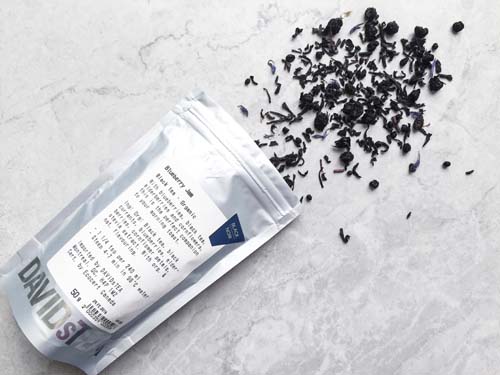
Step 2: Gather Your Tea Tools
Decide on how you’d like to brew your tea, either by using a tea infuser, tea strainer, tea kettle or pot, or a tea infuser travel mug. Whichever tool you decide to use, make sure it’s clean first before brewing.
I’ve decided to use my tea mug with infuser to brew this cup.
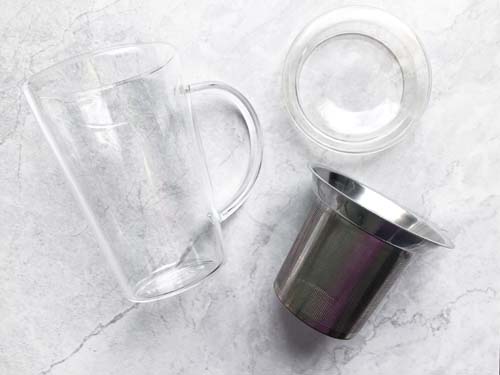
Step 3: Measurement
Determine how many cups of tea you would like to brew and measure your tea leaf-to-water-ratio accordingly. Remember the general rule of thumb of one teaspoon per cup of tea.
In this example I used one perfect teaspoon of leaves per 12 oz of water to make a cup of tea.
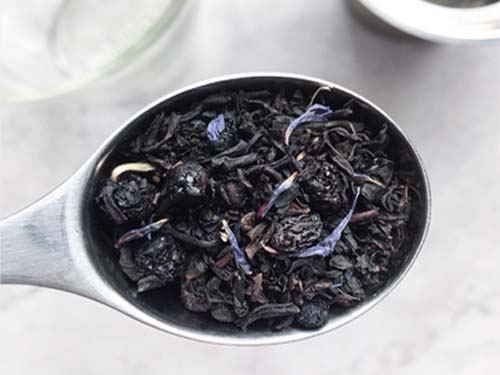
Step 4: Temperature and Time
The temperature to heat your water to and the amount of time to steep your tea leaves for will vary depending on the type of tea you are brewing (refer to temperature and steep time chart above).
As Blueberry Jam is a back tea, I heated the water to 200°F and steeped for about 4 minutes.
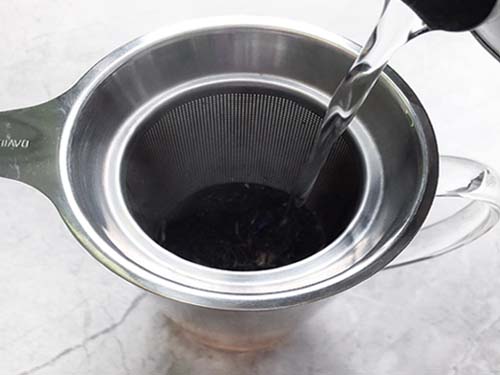
Step 5: Start Steeping!
Simply place your tea leaves inside the infuser and place inside your mug, cup, or kettle for steeping. Pour in the hot water over the tea infuser, and let it steep for the appropriate amount of time.
Make sure the tea infuser is fully submerged in the water so your tea leaves can properly expand and brew. Once the appropriate amount of time has passed, you can remove the tea infuser. Afterwards you can also add in milk and sugar if you like. The tea leaves can also be re-used if you wish to make more than one cup of tea.
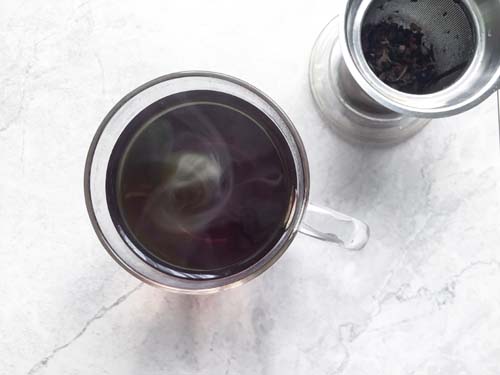
Don’t forget to let your tea cool down a bit before drinking!
Here is a short video that shows how to brew loose leaf tea:
Shop this video:
Why Brew Loose Leaf Tea?
Most people who drink tea typically use tea bags because they’re convenient to use, cheap, and easy to clean.
All you have to do is drop the bag in your cup of hot water and you’re good to go.
Sure this makes tea brewing easy, but the down side to using tea bags is that you’re usually not getting the best cup of tea.
This is because most tea bags are mass produced in factories.
The large volume of tea companies can pump out is a major reason why their cost is lower compared to loose leaf. It’s a low quality tea. Teas commonly produced in factories are also known as ‘tea fannings’ or ‘dust’ due to the appearance of the tea.
Tea bags are also made from filtered paper, silk, or food grade plastic. This may also affect the quality of your tea. If the tea bag isn’t held together by a staple, then chances are glue has been used to help keep the bag together.
Loose leaf teas offer a much better quality and better flavor of tea compared to tea bags. With loose leaf tea you can control the taste and flavor of your tea by deciding which tea leaves to use, how much to use, and what to brew the leaf in.
It’s tempting to purchase pre-packaged tea bags as they are usually cheaper in comparison to loose leaf tea. However in the long run, loose leaf tea is actually cheaper than purchasing tea bags.
Typically tea bags are one time use, whereas tea leaves can be reused multiple times. You can get more servings out of loose leaf tea than from a single tea bag.
The flavor from reusing tea leaves also tastes much better than the flavor of reusing tea bags (at least in my opinion from the tea bags that I have tried).
In terms of bang for your buck, it’s cheaper, and better for you, to use loose leaf tea as opposed to standard tea bags.
Switching from bagged tea to loose leaf tea may seem like a bit of effort in the beginning, but once you do you’ll wish you have done so sooner.
You’ll begin to notice how much better tea tastes.
Caffeine in Tea
Did you know that tea also contains caffeine?
Although tea does not have as much caffeine as coffee does, some types of teas can still pack a punch.
Below is a handy chart that shows the various levels of caffeine found in different types of teas. Chart is courtesy of Choice Organic Teas.
| Beverage | Caffeine Per 8oz Cup |
| White Tea | 30 – 55mg |
| Green Tea | 35 – 70 mg |
| Oolong Tea | 50 – 75 mg |
| Black Tea | 60 – 90 mg |
| Coffee | 150 – 200 mg |
Black teas are found to have the most amount of caffeine (60-90mg per an 8oz cup) whereas white teas are found to have the least amount of caffeine (30-55mg per 8oz cup).
If you’re looking to move away from caffeine but still need something in the mornings to help wake you up, you should try experimenting with different types of black teas.
Loose Leaf Tips
- You can often reuse loose leaf tea up to 2-3 times, depending on the tea leaf
- Keep your loose leaf tea in a sealed container or jar and store in a cool, dry place (such as a cabinet or pantry)
- Do not leave loose tea leaves in direct sunlight
- Try not to over steep teas as they will taste bitter
- If you would like a stronger brew, try using more tea leaves instead of steeping longer
- Keep in mind that tea also contains caffeine, although not as much as coffee does
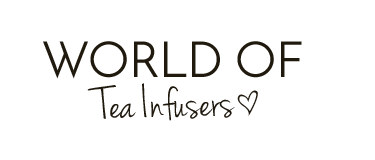
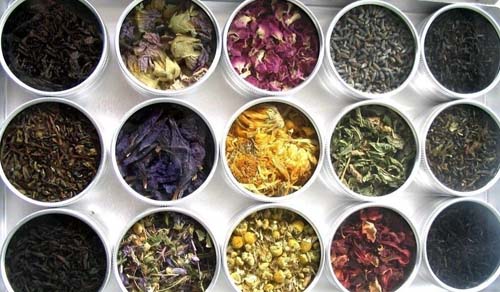
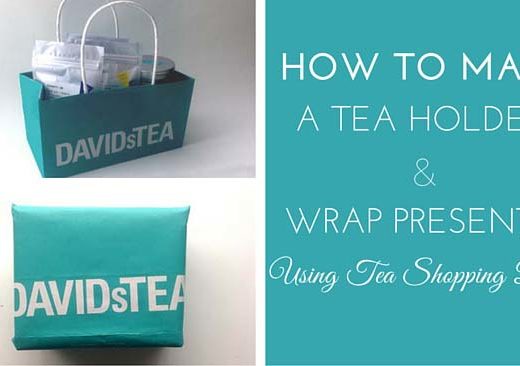
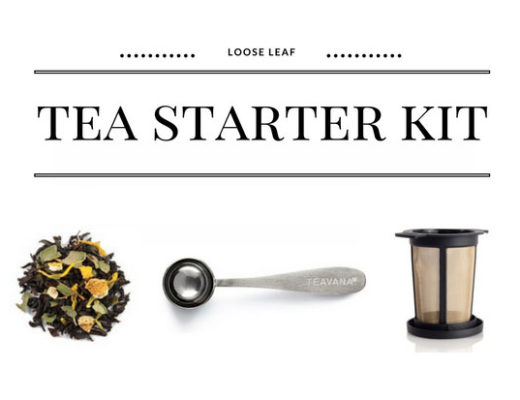
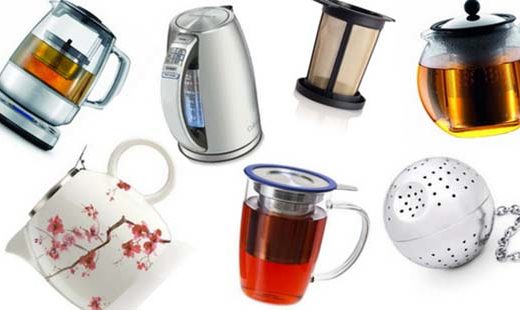
No Comments